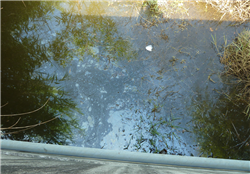 |
| (Source: Jacksonville Integrated Planning Project Skeo Solutions) |
Most of the environmental issues our Eastside community faces derives from the lack of environmental awareness and concern during the periods between the Industrial Revolution and the major environmental legislative movement of the early 1970s. After this period, once heavy industries began declining in the area, a gradual degradation was seen with severe environmental contamination from industrial sites, high unemployment rates and overall urban decay. According to an environmental survey conducted on Jacksonville’s Eastside in 2001, evidence indicated that approximately 27% of the 2,000 properties examined were impacted by some type of chemical contamination. This survey shows that there is a higher concentration of potentially contaminated sites in our neighborhood than any other urban area in North Florida. Some of the industries that contributed to the pollution and contamination in the Eastside and surrounding areas include landfill sites, wood treatment facilities, and pesticide companies.
 |
| (Click to Enlarge Source: Jacksonville Integrated Planning Project Skeo Solutions) |
Polluted waterways are also a concern for us. The St. Johns River, which flows through the region, is part of a program though the Florida Department of Environmental Protection (FDEP), in accordance with the EPA, that tracks the maximum amount of a pollutant a waterway can have and still safely meet state water quality standards.
A part of this system consists of three creeks which flow directly through the East Jacksonville Community – Deer, Hogan, and Long Branch. Through monitoring initiatives, these creeks have been shown to possess fecal coliform contamination as well as low dissolved oxygen levels outside the levels necessary for fishable, swimmable, and drinkable waters. In addition, previous studies by EPA have indicated that the sediments in Deer Creek have been heavily contaminated by both former and current industrial tenants located within the watershed. Industrial operations contributing to this contamination include pesticide and fertilizer, pulp and paper, chemical formulation and manufacturing, wood treatment, and storage of creosote-treated wood products.
Until the 1980s, the U.S viewed wetlands as wild and hostile lands that needed to be tamed. As a result, early Florida pioneers decimated many of the wetlands closely correlating with the three creeks through dredging and filling, until the Emergency Wetlands Act of 1968. Although some wetlands remain, this phenomena has contributed to some of the negative environmental impacts seen in the watershed today.
Lastly, our area is host to the largest wastewater treatment plant in North Florida (JEA’s Buckman Waste Water Treatment Plant). The plant contributes to the air pollution seen in the community, emitting odors which interfere with human well-being. In addition, scientifically proven, due to the fairly large amount of vehicular and ship traffic in the region, the Eastside is threatened by high concentrations of Carbon Monoxide and other related contaminants in the atmosphere.
Testimonials
Resident Quote
“The Eastside Environmental Council is a Guardian Angel for my Community Village.”
— Ariane L. Randolph
Board Member Quote
“What you do can be good or it can be bad but when it comes to the consequences ethier way your happy or sad.”
— Mrs. I. Bowlson
Resident
“A community with disparity has very little to learn because they live it graciously with a lot of equity they’ve earned so if you visit one, a community that’s in despair just pull up a chair and ask them what is going on they’ll take you there.”
— Mrs. W. Wright

